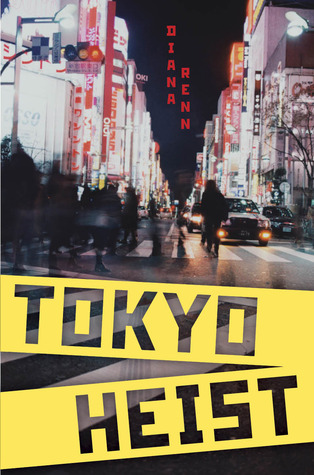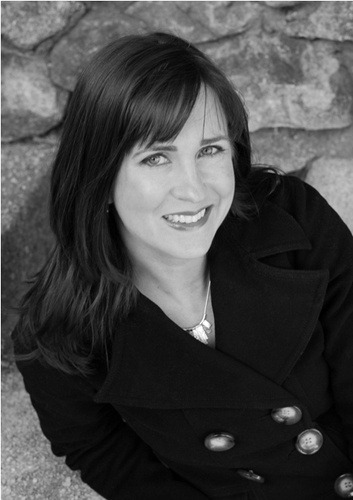Meet Diana Renn, author of Tokyo Heist!
Byrt: Diana, when did you first discover your love for all things Japanese?
DR: I’ve been fascinated by Japan for as long as I can remember. I grew up in Seattle, where you can find a lot of Japanese culture. I was friends with a Japanese exchange student in elementary school. And I remember learning “Sakura,” the cherry blossom song, in grade school – I still know all the words! When I was a teenager I loved to haunt the Japanese import shops in the University district. My dad’s office was near what was once called Japan Town, and I loved going to Japanese restaurants. In my adult life, I’ve enjoyed reading books by Japanese authors, in translation, as well as Japanese art.
Byrt: Was your vacation in Japan anything like Violet’s?
DR: My husband and I went to Japan for our honeymoon. We spent three weeks there, traveling around by trains, visiting friends, and trying to have a wide range of experiences. We had an amazing trip, and a challenge I faced in writing this book was separating my experience from Violet’s and mentally throwing away the Frommer’s Guide. Violet’s on her own trip. Her experiences are not mine. For awhile I was trying to force her to go to places I’d been to that I thought would be cool to include. That wasn’t working, and I realized there was no real reason for her to go to all the places I’d been; those side trips didn’t serve the story.
Byrt: Even when Violet does follow in my footsteps and visit some places I went to – like a street festival in Kyoto, or a famous temple, or the Harajuku district – we are different people, so she is struck by certain details that I might not have noticed. I had to train myself to see those places through HER eyes.
DR: I also wasn’t fleeing from gangsters there, fortunately — though I did see one or two!
 Byrt: Was there any heist in real life that inspired the events of Tokyo Heist? Or if not, how did you go about researching the art world?
Byrt: Was there any heist in real life that inspired the events of Tokyo Heist? Or if not, how did you go about researching the art world?
DR: There was no specific heist that I used as a model for the crime in this book. However, I am really drawn to the 1990 Isabella Stuart Gardner Museum heist in Boston, which is one of the most devastating art heists in history and remains unsolved. I read about that heist a lot in order to understand how criminal networks operate in the art world, and to understand various motives and strategies for stealing art. I spent some time in that museum just looking at the empty frames that remain on the walls and feeling the impact of that loss. Those empty frames haunt me. When I think that those paintings might never reappear, and are lost to the world, I feel profoundly sad. I tried to use some of that feeling as I described Kenji and Mitsue Yamada’s loss of their van Goghs.
I also have friends and family members who work in the art world in various roles – art buyers, conservators, artists, etc. I pestered them with questions. I read extensively about artists – especially van Gogh and Hiroshige – as well as art world jobs. And I spent a couple of weeks at the Museum of Fine Arts in Boston volunteering in a conservation department. I got to shadow a real art conservator and work hands-on with Japanese prints. In the process I learned a lot about that art form as well as how conservators work.
Byrt: In Tokyo Heist, Violet often turns to her favorite manga series, Vampire Sleuths, for sleuthing inspiration – is Vampire Sleuths a real manga series? And if not, how did you come up with it?
DR: It is not a real series. I wanted Violet to be obsessed with an outrageously long-running series; in the novel, this series is up to number 43. I’ve read some YA mysteries where sleuths are obsessed with Sherlock Holmes and pick up some sleuthing tips there. I felt she’d turn to manga, and I needed a mystery series. There are manga mysteries out there (Case Closed is a fun one, though maybe a bit young for Violet, and Death Note has a strong mystery/investigation component). I considered using those for her guides, but then I’d have to study them closely, and I’d also risk dating the book – in five years, will people still be reading Death Note? I don’t know. It freed me up to make up my own series and have it serve my purposes. I may have modeled the title after Vampire Knights, another long-running series that has many fans. And it’s my little inside joke to have Vampire in the manga title. Just a play on how popular vampire titles are (or were when I started writing this book!)
Byrt: What are your favorite manga series?
DR: I think Death Note is really creative and compelling; that was a pleasant surprise for me because I initially found the title and cover off-putting, and then tried it and loved the whole premise. I think Fruits Basket has an engaging art style. I recently discovered Bakuman, which is about two friends who try to draw and write their own manga, and Genkaku Picasso, where a budding young artist uses his artistic abilities to save lives. Great concept, really fun art. I like stories about average students or somewhat marginalized people who discover their talents and strengths.
Byrt: Have you ever been mocked for being a manga fan, as Violet is?
DR: No. I actually didn’t read manga at Violet’s age because it wasn’t around, in translation, to the degree that it is today. I wasn’t into comics or graphic novels at her age either. But in college, my summer job was at store in Seattle that sold books – I was a bookseller – and comics. Back in the early 1990s, manga was beginning to get noticed, and I remember looking at some and reading the classics (like Akira); we also showed Japanese anime films in the store constantly. So Hayao Miyazaki came onto my radar around then, and I fell in love with his work. We showed some films that weren’t dubbed or subtitled, and it became an interesting challenge to figure out what was going on from visuals alone. I became interested in anime and in sequential art around then, but I was an English major and kind of snobby about that, so I kept my growing interest a bit under wraps. I’m sure that on some level, concern about what other people might think – even in college — kept me from purchasing comics/manga and exploring this interest further.
So I wasn’t mocked for being a manga fan because I came to manga so late, and mostly through researching this book. But while working in that comic book shop, I could see how the place was a kind of safe haven for comics fans of all ages. Even older people – businesspeople – would pop in on their lunchbreaks to browse the racks, and would visibly relax.
On some level, I could understand Violet’s feeling of being mocked for her interest. In high school I had some eclectic reading tastes. And I remember how the mainstream crew in high school sometimes mocked the art students/artistic types, and that always bothered me. I never understood why some kids could openly express their passion for popular music groups, or TV shows, or sports, while students with a passion for certain types of art, or comics, seemed to face more scrutiny and judgment.
In your review, you note that manga fans like Violet are “a sub-culture that is weirdly both hugely popular and yet largely scorned by the mainstream.” I am really interested in that paradox.
Byrt: And for the people who have never read manga/watched anime before in their lives, what series/shows would you recommend as a good starting point?
DR: For anime, I’d start with anything by Hayao Miyazaki/Studio Ghibli. The first anime I loved was Kiki’s Delivery Service, and it remains one of my favorites. I love the artistic style and the complete lack of computer animation. Watching his films is like inhabiting drawings.
I didn’t grow up with Sailor Moon like Violet did, but it’s a charming series and I know many people start there. Honestly, since I’m not an expert, for advice I’m going to outsource to Robin Brenner’s No Flying No Tights website. Go there. Go there now. It’s an awesome site. Ms. Brenner is a teen librarian who’s written extensively on manga, and this site gives lots of manga recommendations by genre and as appropriate for various age groups. I think there’s a type of manga out there for just about everyone, and her site is a great jumping off point.
Byrt: Also I hear you’re a fan of taiko drumming – what is taiko drumming, exactly?
DR: Taiko drumming is a combination of martial arts, dance, and song. Taiko drums come from Japan, and taiko drumming has been around in American culture, with its own jazzy flair, since the 1950s. Taiko drums were traditionally used for spiritual ceremonies and festivals, and the most common types you see are large, barrel shaped drums played on with long, thick sticks called bachi. But there are also smaller types of drums, which produces different types of sounds. A big part of taiko is ensemble drumming, playing with a group, and a variety of drum types may be used in a group. I’ve been studying taiko with a group in New England for about two years now, and occasionally perform with them.
Byrt: And lastly, what’s coming up next for you? Are there any new books on the horizon? Will there be another mystery for Violet to solve?
DR: I’m currently writing another YA mystery, with a strong element of international intrigue. This one takes us to South America. Different cast, very different sleuth. I have ideas for several more YA mysteries with international settings. Tokyo Heist sold as a standalone book, but I loved writing about these characters and I have ideas brewing for one or two more Violet books. I get asked this question a lot. So we will see!
Thanks again to Diana for stopping by the Yurt!
For more on all things Diana, you can find her website here.
And you can find our review of Tokyo Heist here.







Leave a Reply